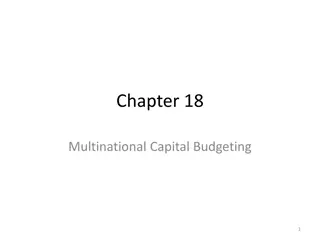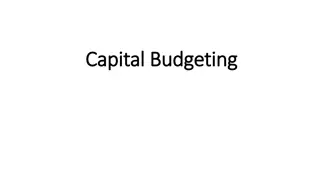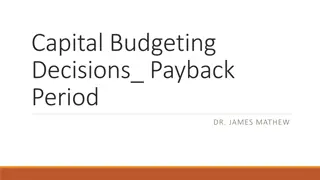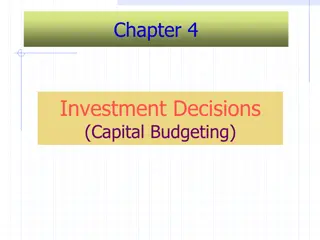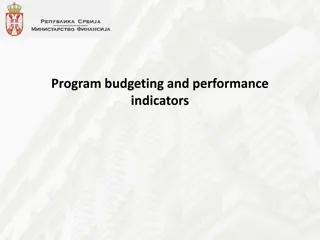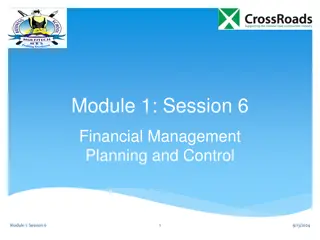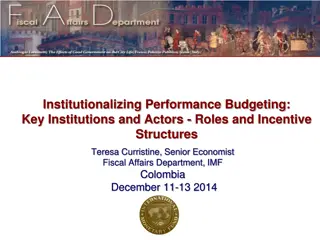
Internal Rate of Return (IRR) and Investment Evaluation Methods
Learn about Internal Rate of Return (IRR), Simple and Non-Simple Investments, Investment Classification, Methods for Determining IRR, and Direct Solution Method in project evaluation. Discover how to assess projects based on IRR and make informed investment decisions effectively.
Download Presentation

Please find below an Image/Link to download the presentation.
The content on the website is provided AS IS for your information and personal use only. It may not be sold, licensed, or shared on other websites without obtaining consent from the author. If you encounter any issues during the download, it is possible that the publisher has removed the file from their server.
You are allowed to download the files provided on this website for personal or commercial use, subject to the condition that they are used lawfully. All files are the property of their respective owners.
The content on the website is provided AS IS for your information and personal use only. It may not be sold, licensed, or shared on other websites without obtaining consent from the author.
E N D
Presentation Transcript
Lecture 10 SEPPA 08 Aug 2016
Internal Rate of Return (IRR) IRR is the interest rate earned on the unrecovered project balance of investment such that, when the project terminates, the unrecovered project balance will be zero. NPV = A0/(1+i*)0+ A1/(1+i*)1+ A2/(1+i*)2 .+ An/(1+i*)n =0 3/19/2025 2
Internal Rate of Return (IRR) Simple Investments A simple investment is defined as that investment, when the sign change in the project cash flow occurs only once. A non-simple investment is that investment where the sign change occurs more than once. 3/19/2025 3
Investment Classification Investm ent type 0 period 1 2 3 4 5 Simple - + + + + + Simple - - + + 0 + Non- simple _ + _ + + _ Non- simple _ + + - 0 + 3/19/2025 4
Internal Rate of Return (IRR) Methods of project Evaluation by IRR If IRR>MARR, accept the project If IRR = MARR, remain indifferent If IRR < MARR, reject the project 3/19/2025 5
Methods for determining IRR 1.The direct-solution method 2.The trial-and-error method, and 3.The graphic method 3/19/2025 6
Direct Solution Method n Project 1 Project 2 1 -$1,000 _$2,000 2 0 1,300 3 0 1,500 4 0 5 1,500 3/19/2025 7
Direct Solution Method Project 1 = + = = * * ( ) $1,000( $1,000( = + / , ,4) $1,500 / , ,4) F P i 0 + FV i F P i * * 4 ) $1,500 1.5 $1,000(1 i = * 4 ) (1 i 1 4 = = * 1.5 0.1067 10 7% or 1 i * .6 i 3/19/2025 8
Direct Solution Method Project 2 NPV $1,300 (1 + $1,500 (1 + $2,000 = + + = 0 2 ) ) i i Let 1 + = = x (1 ) i + + = 2 $2,000 $1,300 $1,500 0 NPV x x 1,300 2 4(1,500)( 2,000) 2(1,500) 3,700 3,000 1.667 or 1,300 = x 1,300 = x = 0.8 x 1 + = 0.8 1 i = 25% i 3/19/2025 9
DCF Model A hydropower plant of 900 KW needs an investment of Rs 18 crores. The plant does not have to pay income taxes for 10 years and Nepal Electricity Authority (NEA) has given assurance to buy the power at Rs 6 NR per KWh. After 10 years the income tax rate is 50% of the existing income tax rate (25%).The economic life of the plant is 20 years. The annual operating and maintenance cost is 5% of the revenue. The annual escalation rate for the O & M cost is 5%. The depreciation rate is 15% of the fixed assets with declining balance method. The fixed assets are 95% of the investment. The annual insurance cost is 0.25% of revenue. The price at which NEA buys power will be increased every year at 6% for the initial five years, but after five years it will be constant. The annual capital expenditure needed will be 2.5% of the revenue. The Hydropower plant has to be handed over to the Govt. after 15 years. Develop a Discounted Cash Flow (DCF) model for the project and find out whether the project is feasible or not.



